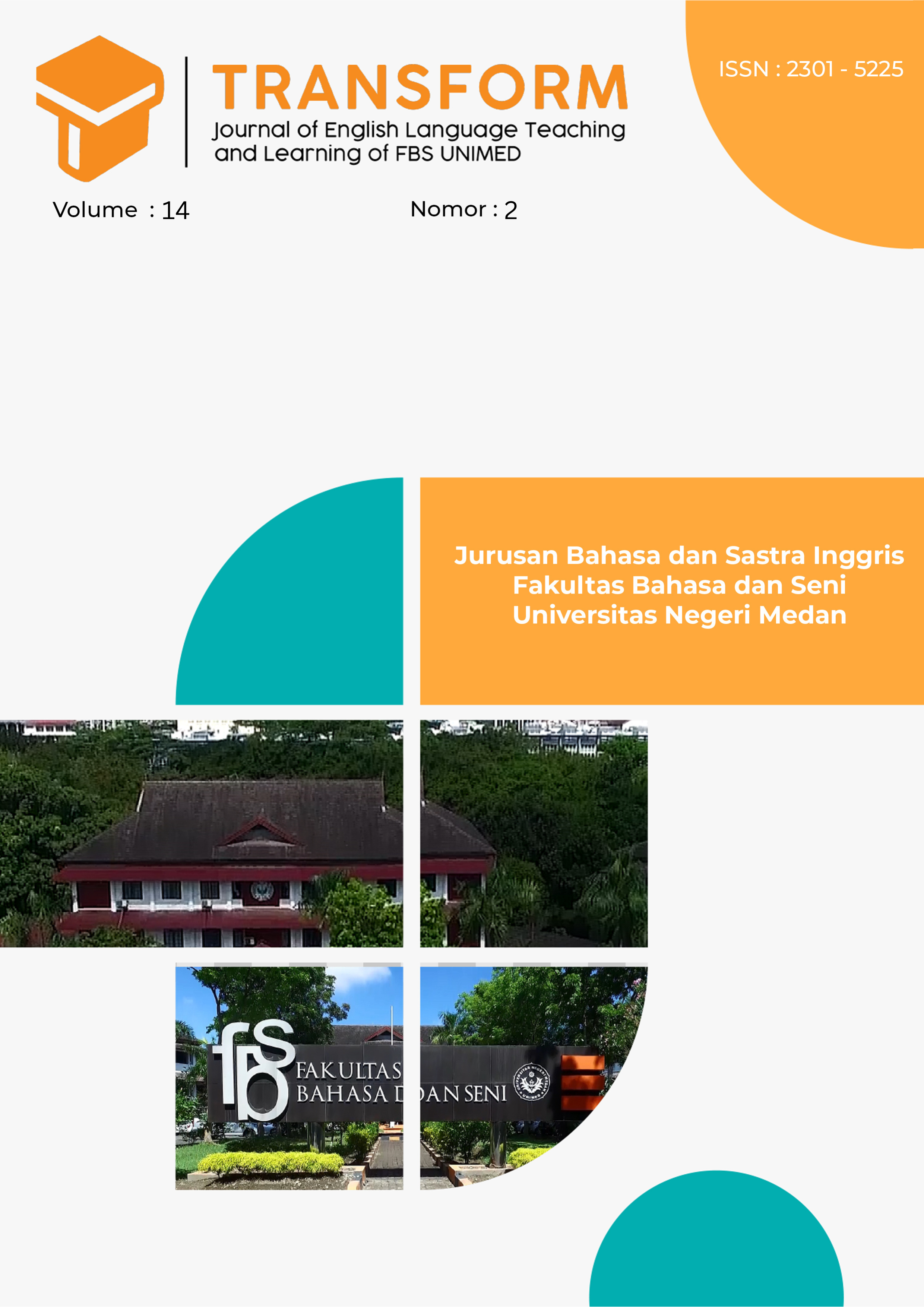Students’ Perceptions on The Implementation of Problem-Based Learning at SMKN 8 Medan
DOI:
https://doi.org/10.24114/tj.v14i2.67361Keywords:
Students' Perceptions, Problem-Based Learning (PBL), Writing Skill, Procedural TextAbstract
This study is aimed to analyze students’ perceptions on the implementation of Problem-Based Learning (PBL) in writing procedural texts at Grade X Culinary Arts 5 at SMKN 8 Medan. Employing a qualitative approach, the data were obtained through questionnaire, classroom observation, and semi-structured interview. Thirty-five students from X Culinary Arts 5 served as the source of the data. The questionnaire consisted of eight closed-ended statements adapted from Zahra and Baa (2021), which measured students’ perceptions based on key indicators such as curiosity and independent learning, organization and writing process, collaboration and communication, and vocabulary and writing skills development. Classroom observations documented real-time engagement and interactions during PBL activities, while semi-structured interview captured students’ experiences and thoughts on PBL implementation. The findings revealed that students generally perceived PBL positively, noting its effectiveness in enhancing writing skills, particularly in structuring procedural texts and expanding vocabulary. This study highlights that PBL is more effective when students possess a practical orientation and a collaborative mindset, as seen in Culinary Arts students who connected procedural texts with real-world applications. Although some students faced challenges in adapting to problem-solving tasks, PBL fostered collaboration, encouraged independent learning, and increased motivation, making it a highly interactive and beneficial approach to learning procedural texts in a vocational educationReferences
Arends, R. I. (2012). Learning to teach (9th ed.). McGraw-Hill.
Aslam, M., Jamil, H., & Saeed, M. (2021). Effectiveness of problem-based learning on students’ achievement in English writing skills. Journal of Educational Research, 24(2), 55–65.
Creswell, J. W. (2012). Educational research: Planning, conducting, and evaluating quantitative and qualitative research (4th ed.). Pearson Education.
Darling-Hammond, L., Barron, B., Pearson, P. D., Schoenfeld, A. H., Stage, E. K., Zimmerman,
T. D., Cervetti, G., & Tilson, J. L. (2008). Powerful learning: What we know about teaching for understanding. Jossey-Bass.
Goldstein, E. B. (2010). Cognitive psychology: Connecting mind, research, and everyday experience (3rd ed.). Wadsworth Cengage Learning.
Irwanto. (2002). Psikologi umum. Jakarta: PT Rineka Cipta.
Knapp, P., & Watkins, M. (2005). Genre, text, grammar: Technologies for teaching and assessing writing. University of New South Wales Press.
Miles, M. B., Huberman, A. M., & Saldaña, J. (2014). Qualitative data analysis: A methods sourcebook (3rd ed.). SAGE Publications.
Mulyadi, D., Handayani, E., & Ramadhan, M. A. (2025). Enhancing vocational students' independence and critical thinking through problem-based learning. Journal of Technical Education and Training, 13(1), 33–41.
Sugiyono. (2013). Metode penelitian pendidikan: Pendekatan kuantitatif, kualitatif, dan R&D. Alfabeta.
Tan, O. S. (2003). Problem-based learning innovation: Using problems to power learning in the 21st century. Thomson Learning.
Zahra, S. Q., & Baa, M. (2021). Students’ perceptions of problem-based learning in writing class: A case study. Journal of Language Teaching and Research, 12(3), 412–420.
Zahra, S. Q., & Samsi, A. (2022). Collaborative learning through PBL in EFL classrooms.
International Journal of Education and Literacy Studies, 10(2), 86–93.
Zulkarnain, N., Rahmah, N., & Hidayatullah, H. (2022). Improving students’ writing skill through PBL approach. ELT Worldwide: Journal of English Language Teaching, 9(1), 19–27.
Downloads
Published
How to Cite
Issue
Section
License
Copyright (c) 2025 Afifah Zahra Atamy

This work is licensed under a Creative Commons Attribution-ShareAlike 4.0 International License.
Authors who publish with this journal agree with the following terms:
- Authors retain copyright and grant the journal right of first publication with the work simultaneously licensed under a Creative Commons Attribution License that allows others to share the work with an acknowledgment of the work's authorship and initial publication in this journal.
- Authors are able to enter into separate, additional contractual arrangements for the non-exclusive distribution of the journal's published version of the work (e.g., post it to an institutional repository or publish it in a book), with an acknowledgment of its initial publication in this journal.
- Authors are permitted and encouraged to post their work online (e.g., in institutional repositories or on their website) prior to and during the submission process, as it can lead to productive exchanges, as well as earlier and greater citation of published work (See The Effect of Open Access).
- This work is licensed under a Creative Commons Attribution-ShareAlike 4.0 International License.








